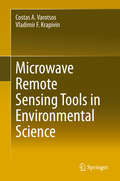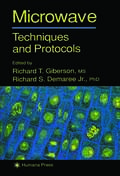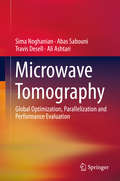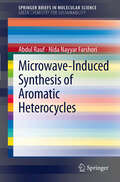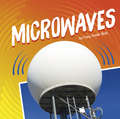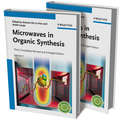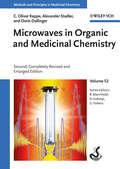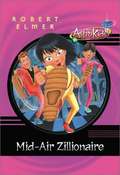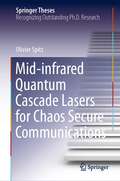- Table View
- List View
Microwave Remote Sensing Tools in Environmental Science
by Vladimir F. Krapivin Costas A. VarotsosThis book gives new insight to the study of the global environmental changes using the ecoinformatics and microwave remote sensing tools together with the adaptive-evolutionary technology of geoinformation monitoring. The main advantage of this book consists in the accumulation of the interdisciplinary scientific knowledge for the parameterization of the global biogeochemical cycles and other environmental processes in the context of globalization and sustainable development. In this regard, the crucial global problems of the dynamics of the climate-nature-society system have been considered and the key problems of ensuring its sustainable development have been addressed. An analysis of the present trend in changing ecological systems has been discussed, including different types of forest ecosystems and ocean aquatories. The emphasis has been given to the accomplishment of the global geoinformation monitoring, which could provide a reliable control of the environmental processes development with reliable prognostic estimates of the consequences of human activities. A new approach to the numerical modelling of the climate-nature-society system has been presented and demonstrative results have been given about the modelling of the dynamics of this system‟s characteristics, in cases of realization of some scenarios of the anthropogenic impacts to the biogeochemical cycles, the land ecosystems and oceans. Methods and algorithms for the big data manipulation and processing in the remote sensing environmental monitoring systems have been described.
Microwave Spectroscopy (Dover Books On Physics Series)
by A. L. Schawlow C. H. TownesTwo Nobel Laureates present a systematic, comprehensive account of the theory, techniques, experimental data, and interpretation involved in the study of microwave spectroscopy. Eighteen self-contained chapters on key topics may be read individually or serially, making this volume ideal as a reference as well as a textbook. 190 tables and figures. 1955 edition.
Microwave Techniques and Protocols
by Richard T. Giberson Richard S. Demaree Jr.Richard Giberson and Richard Demaree, Jr, have collected a wide range of time-saving microwave techniques for processing biological samples for evaluation by many different microscopic methods. Described in step-by-step detail by hands-on researchers, these readily reproducible protocols include both optimized classic methods and such state-of-the art techniques as in vivo labeling, formalin fixation of fresh tissue, vacuum processing, and processing for scanning electron microscopy. Each stand-alone microwave method has been handcrafted by a researcher who regularly uses it to ensure processing success and the brightest quality result.
Microwave Tomography
by Sima Noghanian Abas Sabouni Travis Desell Ali AshtariThis book provides a detailed overview on the use of global optimization and parallel computing in microwave tomography techniques. The book focuses on techniques that are based on global optimization and electromagnetic numerical methods. The authors provide parallelization techniques on homogeneous and heterogeneous computing architectures on high performance and general purpose futuristic computers. The book also discusses the multi-level optimization technique, hybrid genetic algorithm and its application in breast cancer imaging.
Microwave, Infrared, and Laser Transitions of Methanol Atlas of Assigned Lines from 0 to 1258 cm-1: Atlas Of Assigned Lines From 0 To 1258 Cm
by Giovanni MoruzziThis unique atlas presents the recorded spectrum of CH3OH, the main isotopic species of methanol, in the range 28-1258 cm-1. The spectral plot is accompanied by a list of all currently assigned rotation-torsion-vibration lines in the absorption spectrum of methanol. The list of nearly 35,000 transitions spans all of the known microwave transitions, as well as the region of coincidence with CO2 laser emissions.
Microwave-Induced Synthesis of Aromatic Heterocycles
by Nida Nayyar Farshori Abdul RaufFor more than a century, heterocycles have played a crucial role in the biological and industrial development of society, becoming one of the most researched areas within organic chemistry. The first chapter of Microwave-Induced Synthesis of Aromatic Heterocycles is based on microwave theory, the latest developments in instrumentation technology, and the various microwave technologies used for synthesis. The remainder of the chapters are divided into two sections. Section A deals with the five-membered heterocycles (pyrazoles, isoxazoles, triazoles, oxadiazoles, thiazoles, imidazoles, oxazoles, oxazolines etc.) and in Section B, various six-membered heterocycles (triazines, benzoxazoles, benzimidazoles, benzothiazoles) are presented. Both sections contain a detailed, recent literature review of microwave assisted synthesis and its applicability to various aromatic heterocyclics.
Microwave-Mediated Biofuel Production
by Veera G. GudeThis book focuses on chemical syntheses and processes for biofuel production mediated by microwave energy. This is the first contribution in this area serving as a resource and guidance manual for understanding the principles, mechanisms, design, and applications of microwaves in biofuel process chemistry. Green chemistry of microwave-mediated biofuel reactions and thermodynamic potentials for the process biochemistry are the focus of this book. Microwave generation, wave propagation, process design, development and configurations, and biofuel applications are discussed in detail.
Microwave-assisted Extraction for Bioactive Compounds
by Giancarlo Cravotto Farid ChematWith increasing energy prices and the drive to reduce CO2 emissions, food industries are challenged to find new technologies in order to reduce energy consumption, to meet legal requirements on emissions, product/process safety and control, and for cost reduction and increased quality as well as functionality. Extraction is one of the promising innovation themes that could contribute to sustainable growth in the chemical and food industries. For example, existing extraction technologies have considerable technological and scientific bottlenecks to overcome, such as often requiring up to 50% of investments in a new plant and more than 70% of total process energy used in food, fine chemicals and pharmaceutical industries. These shortcomings have led to the consideration of the use of new "green" techniques in extraction, which typically use less solvent and energy, such as microwave extraction. Extraction under extreme or non-classical conditions is currently a dynamically developing area in applied research and industry. Using microwaves, extraction and distillation can now be completed in minutes instead of hours with high reproducibility, reducing the consumption of solvent, simplifying manipulation and work-up, giving higher purity of the final product, eliminating post-treatment of waste water and consuming only a fraction of the energy normally needed for a conventional extraction method. Several classes of compounds such as essential oils, aromas, anti-oxidants, pigments, colours, fats and oils, carbohydrates, and other bioactive compounds have been extracted efficiently from a variety of matrices (mainly animal tissues, food, and plant materials). The advantages of using microwave energy, which is a non-contact heat source, includes more effective heating, faster energy transfer, reduced thermal gradients, selective heating, reduced equipment size, faster response to process heating control, faster start-up, increased production, and elimination of process steps. This book will present a complete picture of the current knowledge on microwave-assisted extraction (MAE) of bioactive compounds from food and natural products. It will provide the necessary theoretical background and details about extraction by microwaves, including information on the technique, the mechanism, protocols, industrial applications, safety precautions, and environmental impacts.
Microwaves (Waves in Motion)
by Tracy Vonder BrinkMicrowaves heat our food. They carry messages from phone to phone. They help detect the weather. Microwaves are all around us, even if we don't see them. With engaging, at-level text and colorful images, readers will learn about microwaves and how we use them every day.
Microwaves in Catalysis
by Nick Serpone Satoshi HorikoshiA comprehensive overview covering the principles and preparation of catalysts, as well as reactor technology and applications in the field of organic synthesis, energy production, and environmental catalysis. Edited and authored by renowned and experienced scientists, this reference focuses on successful reaction procedures for applications in industry. Topics include catalyst preparation, the treatment of waste water and air, biomass and waste valorisation, hydrogen production, oil refining as well as organic synthesis in the presence of heterogeneous and homogeneous catalysts and continuous-flow reactions. With its practical relevance and successful methodologies, this is a valuable guide for chemists at universities working in the field of catalysis, organic synthesis, pharmaceutical or green chemistry, as well as researchers and engineers in the chemical industry.
Microwaves in Organic Synthesis, 2 Volume Set
by André Loupy Antonio De HozThe third edition of the bestselling two-volume reference covers everything you need to know about microwave technology for synthesis- from the best equipment to nonthermal effects, from solid-support reactions to catalysis. Completely revised and updated with half of the authors completely new to the project, this comprehensive work is clearly divided into two parts on the fundamentals of microwave irradiation, and application of microwaves and synergies with other enabling techniques. Also new to this edition are chapters on on-line monitoring, flow chemistry, combination with ultrasounds and natural products, including multicomponent reactions.An indispensable source for organic, catalytic, physical, and medicinal chemists.
Microwaves in Organic and Medicinal Chemistry
by Alexander Stadler Raimund Mannhold Gerd Folkers Hugo Kubinyi Doris Dallinger C. Oliver KappeTailored to the needs of medicinal and natural products chemists, the second edition of this unique handbook brings the contents up to speed,almost doubling the amount of chemical information with an additional volume.As in the predecessor, a short introductory section covers the theoretical background and evaluates currently available instrumentation andequipment. The main part of the book then goes on to systematically survey the complete range of published microwave-assisted synthesismethods from their beginnings in the 1990s to mid-2011, drawing on data from more than 5,000 reports and publications. Throughout, thefocus is on those reactions, reagents and reaction conditions that work, and that are the most relevant for medicinal and natural productschemistry. A much expanded section is devoted to combinatorial, highthroughput and flow chemistry methods.
Mid-Air Zillionaire (AstroKids #9)
by Robert ElmerBook 9 of AstroKids. Miko learns that she's inherited not just a fortune, but an entire planet! Will her new wealth ruin her friendships and happy life on CLEO7? And can she protect her inheritance from a sneaky developer?
Mid-Atlantic Freshwater Wetlands: Advances in Wetlands Science, Management, Policy, and Practice
by Denice Heller Wardrop Robert P. BrooksThe lands and waters of the Mid-Atlantic Region (MAR) have changed significantly since before the 16th century when the Susquehannock lived in the area. Much has changed since Captain John Smith penetrated the estuaries and rivers during the early 17th century; since the surveying of the Mason-Dixon Line to settle border disputes among Maryland, Pennsylvania, and Delaware during the middle of the 18th century; and since J. Thomas Scharf described the physiographic setting of Baltimore County in the late 19th century. As early as 1881, Scharf provides us with an assessment of the condition of the aquatic ecosystems of the region, albeit in narrative form, and already changes are taking place - the conversion of forests to fields, the founding of towns and cities, and the depletion of natural resources. We have always conducted our work with the premise that "man" is part of, and not apart from, this ecosystem and landscape. This premise, and the historical changes in our landscape, provide the foundation for our overarching research question: how do human activities impact the functioning of aquatic ecosystems and the ecosystem services that they provide, and how can we optimize this relationship?
Mid-Infrared Fluoride and Chalcogenide Glasses and Fibers (Progress in Optical Science and Photonics #18)
by Pengfei Wang Haitao Guo Xunsi Wang Peiqing Zhang Shunbin Wang Shijie Jia Gerald Farrell Shixun DaiThis book gives an overview on mid-infrared optical glass and fibers laser, it cover the underlying principle, historic background, as well as recent advances in materials processing and enhanced properties for rare earth doped luminescence, spectroscopy lasers, or optical nonlinearity applications. It describes in great detail, the preparation of high purity non-oxide IR glass and fibers to be used as mid-IR fiber laser and supercontinuum sources for optical fiber spectroscopy. It will be useful for academics, researchers and engineers in various disciplines who require a broad introduction to the subject and would like to learn more about the state-of-the-art and upcoming trends in mid-infrared fiber source development, particularly for industrial, medical and military applications.
Mid-infrared Quantum Cascade Lasers for Chaos Secure Communications (Springer Theses)
by Olivier SpitzThe mid-infrared domain is a promising optical domain because it holds two transparency atmospheric windows, as well as the fingerprint of many chemical compounds. Quantum cascade lasers (QCLs) are one of the available sources in this domain and have already been proven useful for spectroscopic applications and free-space communications. This thesis demonstrates how to implement a private free-space communication relying on mid-infrared optical chaos and this requires an accurate cartography of non-linear phenomena in quantum cascade lasers.This private transmission is made possible by the chaos synchronization of two twin QCLs. Chaos in QCLs can be generated under optical injection or external optical feedback. Depending on the parameters of the optical feedback, QCLs can exhibit several non-linear phenomena in addition to chaos. Similarities exist between QCLs and laser diodes when the chaotic dropouts are synchronized with an external modulation, and this effect is known as the entrainment phenomenon. With a cross-polarization reinjection technique, QCLs can generate all-optical square-waves. Eventually, it is possible to trigger optical extreme events in QCLs with tilted optical feedback. All these experimental results allow a better understanding of the non-linear dynamics of QCLs and will extend the potential applications of this kind of semiconductor lasers.
Middle Age: A Natural History
by David Bainbridge&“There's lots of good news for the middle aged…A very jolly book with clear scientific explanations.&”—The Telegraph David Bainbridge is a vet with a particular interest in evolutionary zoology—and he has just turned forty. As well as the usual concerns about greying hair, failing eyesight, and goldfish levels of forgetfulness, he finds himself pondering some bigger questions: have I come to the end of my productive life as a human being? And what I am now for? By looking afresh at the latest research from the fields of anthropology, neuroscience, psychology, and reproductive biology, it seems that the answers are surprisingly, reassuringly encouraging. In clear, engaging and amiable prose, Bainbridge explains the science behind the physical, mental and emotional changes men and women experience between the ages of 40 and 60, and reveals the evolutionary—and personal—benefits of middle age, which is unique to human beings and helps to explain the extraordinary success of our species. Middle Age will change the way you think about midlife, and help turn the crisis into a cause for celebration. &“Bainbridge's zoological examination of the human animal results in a study that is full of surprises...Heartening.&”—Sunday Times &“Thought-provoking. [It] should certainly shed some new light on one's own potbellied or menopausal mid-life crisis...Fascinating.&”—Evening Standard
Middle Grade Science 2011 Cells And Heredity:student Edition
by Prentice HallIntroduction to Cells Cell Processes and Energy Genetics: The Science of Heredity The DNA Connection Human Genetics and Genetic Technology Evolution
Middle Grade Science 2011: Astronomy and Space
by Prentice HallHave you ever worked on a jigsaw puzzle? Usually a puzzle has a theme that leads you to group the pieces by what they have in common. But until you put all the pieces together you can't solve the puzzle. Studying science is similar to solving a puzzle. The big ideas of science are like puzzle themes. To understand big ideas, scientists ask questions. The answers to those questions are like pieces of a puzzle. Each chapter in this book asks a big question to help you think about a big idea of science. By answering the big questions, you will get closer to understanding the big idea.
Middle Grade Science 2011: Forces and Energy
by Prentice HallEach lesson begins with a series of Key Concept questions. The interactivities in each lesson will help you understand these concepts and Unlock the Big Question. At the start of each lesson. My Planet Diary will introduce you to amazing events, significant people, and important discoveries in science or help you to overcome common misconceptions about science concepts.
Middle Grade Science 2011: Human Body Systems
by Pearson Prentice HallTopics covered in this book are: the human body, bones, muscles, skin, digestion circulation, respiration, excretion, fighting disease, the nervous system, the endocrine system and reproduction.
Middle Grade Science 2011: Water and the Atmosphere
by Prentice Hall BuckleyContains chapters on: Fresh Water / The Oceans / The Atmosphere / Weather / Climate and Climate Change
Middle Grade Science 2013 Earth
by Prentice-Hall StaffPut your child in the driver’s seat of his or her Science education by using the Interactive Science curriculum for homeschooling. Designed to keep your child invested and interested in the subject, this program offers lessons that are dynamic and hands-on. Rather than simply reading about Science, you and your child will participate in labs and activities that enhance his or her learning experience. <P><P> Interactive Science: Grade 6 is a more challenging curriculum than the other Grade levels, as your child has, by now, a strong foundational knowledge of Science Engineering and Technology, Life Science, Earth Science and Physical Science. These four Science topics are included in all Interactive Science programs. In fact, Interactive Science is broken down into units that mirrors the four key areas of Science education.
Middle Grades Social Studies 2011 Geography Survey (myWorld)
by Prentice-Hall StaffMiddle Grades Social Studies 2011 Geography
